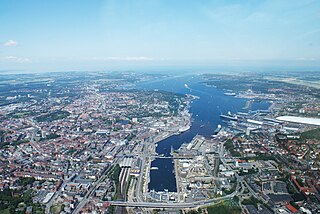
Kiel is the capital and most populous city in the northern German state of Schleswig-Holstein, with a population of 246,243 (2021).
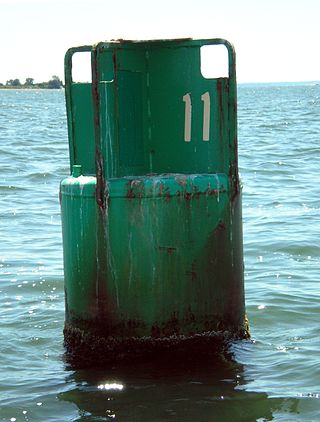
A buoy is a floating device that can have many purposes. It can be anchored (stationary) or allowed to drift with ocean currents.

A fireboat or fire-float is a specialized watercraft with pumps and nozzles designed for fighting shoreline and shipboard fires. The first fireboats, dating to the late 18th century, were tugboats, retrofitted with firefighting equipment. Older designs derived from tugboats and modern fireboats more closely resembling seafaring ships can both be found in service today. Some departments would give their multi-purpose craft the title of "fireboat" also.

SS Nomadic is a former tender of the White Star Line, launched on 25 April 1911 at Belfast, that is now on display in Belfast's Titanic Quarter. She was built to transfer passengers and mail to and from the ocean liners RMS Olympic and RMS Titanic. She is the only surviving vessel designed by Thomas Andrews, who also helped design those two ocean liners, and the last White Star Line vessel in existence today.

The Hörn Bridge is a folding bridge in the city of Kiel in the German state of Schleswig-Holstein. The bridge spans the end of the Kiel Fjord and was designed by Gerkan, Marg and Partners.

SS Princess Sophia was a steel-built passenger liner in the coastal service fleet of the Canadian Pacific Railway (CPR). Along with SS Princess Adelaide, SS Princess Alice, and SS Princess Mary, Princess Sophia was one of four similar ships built for CPR during 1910-1911.

The German Maritime Museum is a museum in Bremerhaven, Germany. It is part of the Gottfried Wilhelm Leibniz Scientific Community. The main museum building was opened on 5 September 1975 by then-president of Germany Walter Scheel, though scientific work already had started in 1971. In 2000, celebrating the 25th anniversary of the museum, the Hansekogge, a ship constructed around 1380 that was found in the Weser river in 1962, was presented to the public after having undergone a lengthy process of conservation in a large preservative-filled basin.

German submarine U-48 was a Type VIIB U-boat of Nazi Germany's Kriegsmarine during World War II, and the most successful that was commissioned. During her two years of active service, U-48 sank 51 ships for a total of 299,477 GRT and 1,060 tons; she also damaged four more for a total of 27,877 GRT over twelve war patrols conducted during the opening stages of the Battle of the Atlantic.
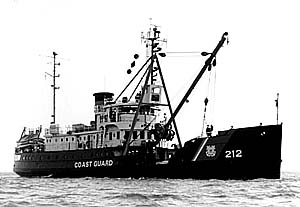
The United States Coast Guard Cutter Fir was the last lighthouse tender built specifically for the United States Lighthouse Service to resupply lighthouses and lightships, and to service buoys. Fir was built by the Moore Drydock Company in Oakland, California in 1939. On 22 March 1939, the U.S. Lighthouse Tender Fir was launched. She was steam driven with twin screws, 175 feet (53 m) in length, had a beam of 32 feet (9.8 m), drew 11 feet 3 inches (3.43 m) of water, and displaced 885 tons. Fir was fitted with a reinforced bow and stern, and an ice-belt at her water-line for icebreaking. She was built with classic lines and her spaces were lavishly appointed with mahogany, teak, and brass. The crew did intricate ropework throughout the ship. The cost to build Fir was approximately US$390,000. Fir's homeport was Seattle, Washington for all but one of her fifty one years of service when she was temporarily assigned to Long Beach, California when USCGC Walnut was decommissioned on 1 July 1982.

The Zoological Museum of Kiel University is a zoological museum in Kiel, Germany. It was founded by naturalist Karl Möbius, and architect Martin Gropius designed the building. The exhibitions display systematics, evolution, tropical and German fauna, butterfly ecology and history of zoology in Kiel. The museum is part of the University of Kiel and participates in the Museen am Meer association.

USCGC Fir (WLB-213) is a Juniper-class cutter of the United States Coast Guard. USCGC Fir is under the Operational Control (OPCON) of the Commander of the Thirteenth Coast Guard District and is homeported in Astoria, Oregon. Fir's primary area of responsibility is the coastal waters, river bars and high seas of the Washingtonian and Oregonian coasts. USCGC Fir conducts heavy lift aids to navigation operations, law enforcement and other missions as directed.
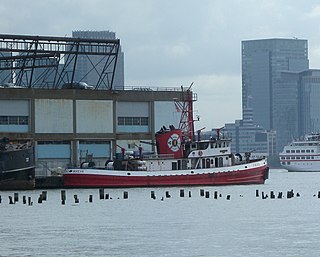
John D. McKean is a fireboat that served the New York City Fire Department as Marine Company 1. She is named after John D. Mckean, who died in a 1953 steam explosion while trying to save a predecessor fireboat, the George B. McClellan.

The Coast Guard Museum Northwest is dedicated to preserving the heritage of the United States Coast Guard in the Pacific Northwest. The museum is located on the property of Coast Guard Station Seattle on the Elliott Bay waterfront south of Downtown, Seattle, Washington. It covers the full range of Coast Guard roles, ranging from protecting shores, lives and property to lighthouses and lightships, from life-saving stations to rescue boats, from buoy tenders to icebreakers and weather ships and from modern aircraft to patrol boats and cutters. The museum admittance is free of charge.

The Frieden is the former German motor vessel Dresden operated by the VEB Deutsche Seereederei Rostock. Since 1970 it has been used as a museum ship.
Museen am Meer is an association of eight museums in the city centre of Kiel, Schleswig-Holstein, Germany, on the edge of Kiel Fjord. The consortium was founded in 2010.

USCGC Kukui (WLB-203) is the third cutter in the Juniper-class 225 ft (69 m) of seagoing buoy tenders and is the third ship to bear the name. She is under the operational control of the Commander of the Seventeenth Coast Guard District and is home-ported in Sitka, Alaska. Her primary area of responsibility is the inland and coastal waters of southeastern Alaska. Kukui conducts heavy lift aids-to-navigation operations, and law enforcement, homeland security, environmental pollution response, and search and rescue as directed.

The City of Long Beach, California started to operate a new fireboat, now known as the Protector, in May 2014. The vessel was known as Fireboat 20, until she was officially commissioned, on June 8, 2016. A sister ship will follow within a year. The two new vessels will replace the Challenger and the Liberty, commissioned in 1987. The earlier vessels had a troubled maintenance record. She will be one of the most powerful fireboats in the world.
The Jura was a wooden, flush deck, paddle steamer, originally built for service on Lake Neuchâtel, but which was sold after seven years to work on Lake Constance, and sank in 1864 after a collision with the Stadt Zürich.
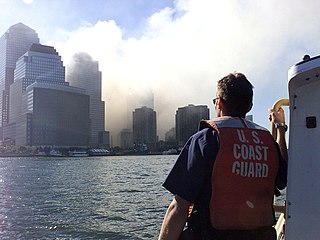
Following the September 11 attacks in New York City, many people were unable to leave Lower Manhattan due to the closure of bridges and tunnels and mass transportation. Within minutes of the first plane hitting the first tower, multiple fireboats from the New York City Fire Department rushed to the scene. The United States Coast Guard coordinated a large convoy of merchant ships, tugboats, and ferries to evacuate the stranded and injured victims.





















